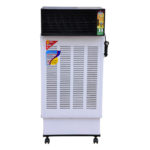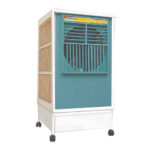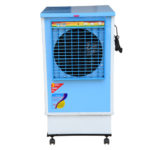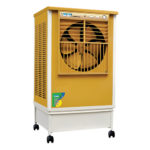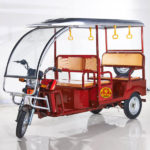
RAM NARAYAN KHER
(FATHER OF COOLER IN INDIA)
Ram was lying down on the flint flooring on that destined noon of May 1953, to relax after his first year Diploma in Engineering, expecting cool breeze through the door. The Khus screen hung-up in the door often had to be wet to help in cooling.
This disturbing solace triggered the concept of keeping of fan before the khus & a tank to hold water to trickle on khus. This swirl of thoughts formed in to an image, a ‘Need fulfilled’,it could all go into a ‘product’, the first cooler in India was conceptualised, named subsequently, after a lot of thought as “WOX” literally meaning nothing! Ram arranged, improved, innovated & constructed. The transformation from a crude wooden structure with sheet metal wrap, to its present day unique looks, a quality product emerged, that has been time tested.
FEATURES
- Four Side Padding for enhanced Cooling.
- Durable Heavy Duty Motors.
- Well Balanced Aluminum Fan Blades.
- Intelligent Water Distribution System.
- Ergonomic Electronic Control.
BENEFITS
- Creates Positive Pressure-Resist Dust accumulation & odour.
- Ventilates cooling area by injecting fresh air.
- Most suitable for Indian Summers.
- Low Power Consumption.
APPLICATION
- Clubs, Resort, Restaurants.
- In open areas, such as waiting Rooms foyars.
- Library, Class Rooms, Shops.
- Bed Rooms, Drawing Rooms.
- Work Shops, Clinics, Chambers, Offices, Hospitals.
Evaporative Cooling
How an Evaporative Cooler Works
In the earlier days, people would often sleep outside on screened-in sleeping porches during the summer. On hot nights, bed sheets or blankets soaked in water would be hung inside of the screens. Whirling electric fans would pull the night air through the moist cloth to cool the room.
That concept, slightly more refined, became the evaporative coolers that to this day provide a low-cost, low-technology alternative to refrigerated air conditioning.
An evaporative cooler produces effective cooling by combining a natural process – water evaporation – with a simple, reliable air-moving system. Fresh outside air is pulled through moist pads where it is cooled by evaporation and circulated through a house or building by a large blower. As this happens, the temperature of the outside air can be lowered as much as 30 degrees.
Probably because evaporative coolers add moisture to the air and blow it around, they are sometimes knows as “swamp coolers.” Evaporative coolers can work wonderfully well, provided the outside air they are drawing in is dry and desert-like. As the humidity increases, however, the ability for them to cool the air effectively decreases. Simply put, swamp coolers were not designed to work in swamp-like conditions.
Air conditioning, on the other hand, became popular because of its ability to cool the air, no matter what the humidity might be. Even on humid days, room and central air conditioners can lower the temperature to a thermostatically controlled temperature. They also use as much as four times as much electricity than swamp coolers do, and they are more expensive to install and maintain. Air conditioners can require ozone-damaging refrigerants, and they recirculate the same air over and over.
Fairly popular in desert areas, swamp coolers will work fine most of the time in California’s more humid climates. Sacramento, for example, averages about 30 percent humidity on a typical hot summer afternoon, still dry enough for evaporative cooling to work effectively. Despite the potential, however, Dick Bourne of the Davis Energy Group estimates that fewer than five percent of California homes and businesses use evaporative cooling.
Want to Know Why Evaporation Lowers Temperature?
The process of evaporation happens all the time. Our bodies, for example, perspire in hot weather; through evaporation the sweat dries and drops our body temperature.
Whenever dry air passes over water, some of the water will be absorbed by the air. That’s why evaporative cooling naturally occurs near waterfalls, at rivers, lakes and oceans. The hotter and drier the air, the more water that can be absorbed. This happens because the temperature and the vapor pressure of the water and the air attempt to equalize. Liquid water molecules become gas in the dry air, a process that uses energy to change the physical state. Heat moves from the higher temperature of the air to the lower temperature of the water. As a result, the air is cooler. Eventually the air becomes saturated, unable to hold more water, and evaporation ceases.
How Evaporative Cooling Works
An evaporative cooler is essentially a large fan with water-moistened pads in front of it. The fan draws warm outside air through the pads and blows the now-cooled air throughout the house.
The pads can be made of wood shavings – wood from aspen trees is a traditional choice – or other materials that absorb and hold moisture while resisting mildew. Aspen wood pads, also called excelsior, need to be replaced every season or two, and generally cost Rs. 150 to Rs.250 for a set.
How an Evaporative Cooler Works
In the earlier days, people would often sleep outside on screened-in sleeping porches during the summer. On hot nights, bed sheets or blankets soaked in water would be hung inside of the screens. Whirling electric fans would pull the night air through the moist cloth to cool the room.
That concept, slightly more refined, became the evaporative coolers that to this day provide a low-cost, low-technology alternative to refrigerated air conditioning.
An evaporative cooler produces effective cooling by combining a natural process – water evaporation – with a simple, reliable air-moving system. Fresh outside air is pulled through moist pads where it is cooled by evaporation and circulated through a house or building by a large blower. As this happens, the temperature of the outside air can be lowered as much as 30 degrees.
Probably because evaporative coolers add moisture to the air and blow it around, they are sometimes knows as “swamp coolers.” Evaporative coolers can work wonderfully well, provided the outside air they are drawing in is dry and desert-like. As the humidity increases, however, the ability for them to cool the air effectively decreases. Simply put, swamp coolers were not designed to work in swamp-like conditions.
Air conditioning, on the other hand, became popular because of its ability to cool the air, no matter what the humidity might be. Even on humid days, room and central air conditioners can lower the temperature to a thermostatically controlled temperature. They also use as much as four times as much electricity than swamp coolers do, and they are more expensive to install and maintain. Air conditioners can require ozone-damaging refrigerants, and they recirculate the same air over and over.
Fairly popular in desert areas, swamp coolers will work fine most of the time in California’s more humid climates. Sacramento, for example, averages about 30 percent humidity on a typical hot summer afternoon, still dry enough for evaporative cooling to work effectively. Despite the potential, however, Dick Bourne of the Davis Energy Group estimates that fewer than five percent of California homes and businesses use evaporative cooling.
Want to Know Why Evaporation Lowers Temperature?
The process of evaporation happens all the time. Our bodies, for example, perspire in hot weather; through evaporation the sweat dries and drops our body temperature.
Whenever dry air passes over water, some of the water will be absorbed by the air. That’s why evaporative cooling naturally occurs near waterfalls, at rivers, lakes and oceans. The hotter and drier the air, the more water that can be absorbed. This happens because the temperature and the vapor pressure of the water and the air attempt to equalize. Liquid water molecules become gas in the dry air, a process that uses energy to change the physical state. Heat moves from the higher temperature of the air to the lower temperature of the water. As a result, the air is cooler. Eventually the air becomes saturated, unable to hold more water, and evaporation ceases.
How Evaporative Cooling Works
An evaporative cooler is essentially a large fan with water-moistened pads in front of it. The fan draws warm outside air through the pads and blows the now-cooled air throughout the house.
The pads can be made of wood shavings – wood from aspen trees is a traditional choice – or other materials that absorb and hold moisture while resisting mildew. Aspen wood pads, also called excelsior, need to be replaced every season or two, and generally cost Rs. 150 to Rs.250 for a set.
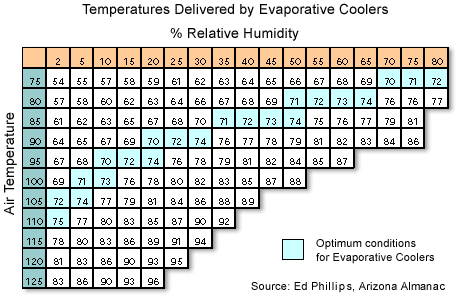
Small distribution lines supply water to the top of the pads. Water soaks the pads and, thanks to gravity, trickles through them to collect in a sump at the bottom of the cooler. A small recirculating water pump sends the collected water back to the top of the pads.
Since water is continually lost through evaporation, a float valve – much like the one that controls the water in a toilet tank – adds water to the sump when the level gets low. Under normal conditions, a swamp cooler can use between 3 to 15 gallons of water a day.
A large fan draws air through the pads, where evaporation drops the temperature approximately 20 degrees. The fan then blows this cooled air into the house.
Small units can be installed in a window, blowing cooled air directly into a room. Larger units can blow air into a central location, or the air can travel through ductwork to individual rooms.
Normal air conditioning is a closed system, taking air from inside a house and recycling it. For air conditioning to function properly, doors and windows should be closed. Evaporative cooling, however, takes air from outside the house. For evaporative cooling to work properly, the cooled outside air must be allowed to escape. By choosing which doors or windows in your home you leave open, you can to help direct the flow of cooled air to areas where it is needed.
Well Do Swamp Coolers Cool?
The temperature of air coming out of an evaporative cooler obviously depends on the temperature and the humidity of the air going in. This chart from the Arizona Almanac shows that an evaporative cooler can deliver comfortable air under a wide variety of typical summertime temperature and humidity ranges.
In addition to the dropping the temperature of the air, evaporative cooling offers an additional cooling benefit. The constant movement of the air created by the blower – the cooling breeze it creates, if you will – makes the occupants of a room feel 4 to 6 degrees cooler than the actual temperature. This is the same effect you feel when you turn on a ceiling fan or a simple window fan. For this reason, the “effective temperature” created by an evaporative cooler will feel 4 to 6 degrees cooler than temperatures shown on the chart.
An added benefit of evaporative cooling is that it works best in the hottest time of the day. As the temperature outside increases as the sun climbs, the humidity normally drops. In the early morning, for example, the temperature may be 70 degrees, with a relative humidity of 60 percent. By mid-afternoon, when the temperature has climbed to 90 degrees, the humidity may well have dropped to 30 percent – conditions that make evaporative cooling work more effectively.
How to choose the right-sized evaporative cooler
For a swamp cooler to effectively cool, it must be the proper size for the job. A small portable unit, for example, will not adequately cool a large-sized room.
While the output of air conditioners are rated in BTUs (British Thermal Units), evaporative coolers are rated by CFMs (the cubic feet per minute of air that the cooler can blow into your home).
Whether it is for a single room or a whole house, there is a simple formula for determining the proper size of swamp cooler you need. Figure the cubic feet of space you want to cool, and then divide that number by two. The quotient will give you the CFM rating for the proper-sized swamp cooler.
For example, if you have a 1,500 square foot home with 8 foot-high ceilings:
1,500 x 8 = 12,000 cubic feet 12,000 % 2 = 6,000 CFM needed
Benefits of Evaporative Cooling
- » Thanks to a new awareness of energy efficiency, evaporative coolers are achieving a new popularity. Remember, swamp coolers use as much as 75 percent less electricity as air conditioning does.
- » Because the technology is simpler, an evaporative cooler costs about half as much as an air conditioner that will cool the same sized area. For perspective, a quick check of the internet in July 2001, found units capable of cooling 750 square feet that were priced as low as $275. Installation costs of swamp coolers are much lesser comparable to air conditioning units.
- » Evaporative coolers operate on 240-volt electricity, which means they don’t need special high-amperage circuits like many air conditioners do. A swamp cooler can be plugged into a nearby outlet.
- » Many people appreciate the fact that evaporative cooling adds moisture to the air, which helps to keep wood furniture and fabrics from drying out. The moist pads through which the outside air flows are also fairly efficient air filters, trapping some dust and pollen. Since the pads are continually wetted, trapped particles are flushed out and trapped in the bottom of the cooler.
- » Air conditioning works best when the windows are closed, since interior air is cooled and recirculated. Because swamp coolers cool outside air and blow it into the house, however, to work effectively they need at least one window open. The cooled outside air vents through open windows or doors, pushing out hot inside air and any smoke, odors and pollution that may be present. With evaporative cooling, a complete air change in a home occurs every one-to-three minutes. This flow of fresh air means that evaporative coolers can be operated without using the water pump to replace warm stale air with cooler nighttime air, much like a whole house fan does. That’s an added benefit.
- » Small evaporative coolers can be often placed in windows, much like a window air conditioner. This requires very little installation. Larger units usually require ducts to distribute the air, but these can be an existing forced air duct system in the house.
- » For the most part, evaporative cooling doesn’t require as much ductwork as air conditioning. For a newly installed system, a short duct can direct the cooled air to a central point in the house. From there, air can be directed through the various rooms by simply opening and closing doors and windows to allow the cooled air to flow.
Well Do Swamp Coolers Cool?
The temperature of air coming out of an evaporative cooler obviously depends on the temperature and the humidity of the air going in. This chart from the Arizona Almanac shows that an evaporative cooler can deliver comfortable air under a wide variety of typical summertime temperature and humidity ranges.
In addition to the dropping the temperature of the air, evaporative cooling offers an additional cooling benefit. The constant movement of the air created by the blower – the cooling breeze it creates, if you will – makes the occupants of a room feel 4 to 6 degrees cooler than the actual temperature. This is the same effect you feel when you turn on a ceiling fan or a simple window fan. For this reason, the “effective temperature” created by an evaporative cooler will feel 4 to 6 degrees cooler than temperatures shown on the chart.
An added benefit of evaporative cooling is that it works best in the hottest time of the day. As the temperature outside increases as the sun climbs, the humidity normally drops. In the early morning, for example, the temperature may be 70 degrees, with a relative humidity of 60 percent. By mid-afternoon, when the temperature has climbed to 90 degrees, the humidity may well have dropped to 30 percent – conditions that make evaporative cooling work more effectively.
How to choose the right-sized evaporative cooler
For a swamp cooler to effectively cool, it must be the proper size for the job. A small portable unit, for example, will not adequately cool a large-sized room.
While the output of air conditioners are rated in BTUs (British Thermal Units), evaporative coolers are rated by CFMs (the cubic feet per minute of air that the cooler can blow into your home).
Whether it is for a single room or a whole house, there is a simple formula for determining the proper size of swamp cooler you need. Figure the cubic feet of space you want to cool, and then divide that number by two. The quotient will give you the CFM rating for the proper-sized swamp cooler.
For example, if you have a 1,500 square foot home with 8 foot-high ceilings:
1,500 x 8 = 12,000 cubic feet 12,000 % 2 = 6,000 CFM needed
Benefits of Evaporative Cooling
Thanks to a new awareness of energy efficiency, evaporative coolers are achieving a new popularity. Remember, swamp coolers use as much as 75 percent less electricity as air conditioning does.
Because the technology is simpler, an evaporative cooler costs about half as much as an air conditioner that will cool the same sized area. For perspective, a quick check of the internet in July 2001, found units capable of cooling 750 square feet that were priced as low as $275. Installation costs of swamp coolers are much lesser comparable to air conditioning units.
Evaporative coolers operate on 240-volt electricity, which means they don’t need special high-amperage circuits like many air conditioners do. A swamp cooler can be plugged into a nearby outlet.
Many people appreciate the fact that evaporative cooling adds moisture to the air, which helps to keep wood furniture and fabrics from drying out. The moist pads through which the outside air flows are also fairly efficient air filters, trapping some dust and pollen. Since the pads are continually wetted, trapped particles are flushed out and trapped in the bottom of the cooler.
Air conditioning works best when the windows are closed, since interior air is cooled and recirculated. Because swamp coolers cool outside air and blow it into the house, however, to work effectively they need at least one window open. The cooled outside air vents through open windows or doors, pushing out hot inside air and any smoke, odors and pollution that may be present. With evaporative cooling, a complete air change in a home occurs every one-to-three minutes. This flow of fresh air means that evaporative coolers can be operated without using the water pump to replace warm stale air with cooler nighttime air, much like a whole house fan does. That’s an added benefit.
Small evaporative coolers can be often placed in windows, much like a window air conditioner. This requires very little installation. Larger units usually require ducts to distribute the air, but these can be an existing forced air duct system in the house.
For the most part, evaporative cooling doesn’t require as much ductwork as air conditioning. For a newly installed system, a short duct can direct the cooled air to a central point in the house. From there, air can be directed through the various rooms by simply opening and closing doors and windows to allow the cooled air to flow.
Drawbacks to Evaporative Cooling
The main drawback of swamp coolers is that they depend on dry outside air to operate effectively. This is usually not a problem for most of India, has dryclimate. On hot, muggy days in the summer, however, swamp coolers will blow hot, humid, soggy air into the house. If the humidity stays high for several days, the moist pads that make the evaporative cooler work can begin to smell, and the musty odor can be blown into the house.
Unfortunately most parts of the India, July and August constitute the rainy season, when monsoon storms sweep. With high temperatures accompanied by high humidity, these months can be the least favorable for swamp coolers.
Evaporative cooling requires water to keep pads wet – a consideration in some areas, especially in drought years. Water consumption can run from three to 15 gallons a day, depending on the size of the swamp cooler and whether or not the water is collected and pumped through the pads more than once. In some areas, discarded water from the unit can be an environmental concern.
Evaporative coolers can be hooked up to existing forced air duct systems. Because the air delivered by an evaporative system will be warmer than the air supplied by an air conditioner, however, evaporative coolers need to produce more air flow. That means the duct system may have to be larger to handle the volume of air and to effectively cool the house.
What’s New
Two stage evaporative coolers have been developed that pre-cool air before it goes through the moistened pad. The new coolers are reported to be as effective as air conditioning, but their initial cost is high – around Rs.2.5 lacs. for a whole house system, approximately the same as air conditioning. The price may come down as more such systems are sold, but for the time being two-stage systems are hard to find.
Evaporative coolers are now on the market that use photovoltaic panels to create the electricity used to run the blower and the water pump. For hot, desert areas, the combination of evaporative cooling and solar power are a perfect match: the afternoon, when the most solar energy is available, is also the hottest part of the day, when cooling is most needed. And since swamp coolers use a fraction of the energy of air conditioners, PV cells can provide enough electricity to run the system effectively.

